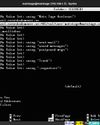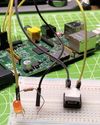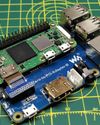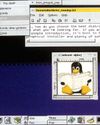Programming a Turing Machine
Linux Format
|January 2021
It was the computer that started it all, albeit in theory. Mike Bedford shows you how to program a Turing Machine and put it through its paces.

Alan Turing is probably best known for his pioneering work on code-breaking at the Government Code and Cypher School at Bletchley Park. In playing a key role in developing the electro-mechanical Bombe that was used to crack the Enigma cipher, Turing had a major impact on shortening World War II by an estimated two years and saving as many as 14 million lives.
Despite having been dubbed the “Father of Modern Computing”, however, his contributions to general-purpose computing are less well-appreciated. And here it’s interesting to note that his design for the ACE computer, a cut-down version of which was eventually built by the National Physics Laboratory in 1950, predated the Manchester Baby, the world’s first stored-program computer, by three years. Arguably, though, his biggest contribution to computing was his vision for a machine that was never actually built, and would have been totally impractical had it ever become a physical reality. This was the so-called Turning Machine and here we look at this model of computing and see how to program it using a couple of simulators.
Turning Machines
Bu hikaye Linux Format dergisinin January 2021 baskısından alınmıştır.
Binlerce özenle seçilmiş premium hikayeye ve 9.000'den fazla dergi ve gazeteye erişmek için Magzter GOLD'a abone olun.
Zaten abone misiniz? Oturum aç
Linux Format'den DAHA FAZLA HİKAYE

Linux Format
Create your first WebSocket service
Mihalis Tsoukalos explains how to use the Go programming language to work with the WebSocket protocol.
9 mins
April 2023

Linux Format
Fantastic Mr Firefox
Nick Peers takes a trip down memory lane to reveal the story behind the rise - and slight fall - of Mozilla's popular web browser.
9 mins
April 2023

Linux Format
Set up your terminal and email like it's 1983
Jump in the hot terminal time machine with Mats Tage Axelsson who emails from the command line using the latest technology.
8 mins
April 2023

Linux Format
Universal layer text effects with GIMP
Posters use them, films and presentations are hard to imagine without them: text effects. Attract attention with Karsten Günther and GIMP.
8 mins
April 2023

Linux Format
Jump to a federated social network
Nick Peers reveals how you can get up and running with this free, decentralised and non-profit alternative to Twitter.
9 mins
April 2023

Linux Format
Free our SOFTWARE!
Taking anything for granted is dangerous, so Jonni Bidwell and Mike Saunders revisit how the free software movement got started to help free us from proprietary tyranny!
4 mins
April 2023

Linux Format
Master RPI.GPIO
Les Pounder goes back to the early days of the Raspberry Pi - and his career with this classic library! -
5 mins
April 2023

Linux Format
Waveshare Zero to Pi3
Transform your Pi Zero into a Pi 3, they promised Les Pounder, but it's more like adding on go-faster stripes.
2 mins
April 2023

Linux Format
The Best OPEN SOURCE Software Ever!
In an attempt to trigger controversy, Michael Reed and Neil Mohr unequivocally state these are the greatest free software apps ever. Probably. We’re just trying to be helpful.
19 mins
April 2023

Linux Format
Linux-Mandrake 7
Simplicity and a wide range of applications make this a great distribution for all Linux users.
2 mins
April 2023
Translate
Change font size

